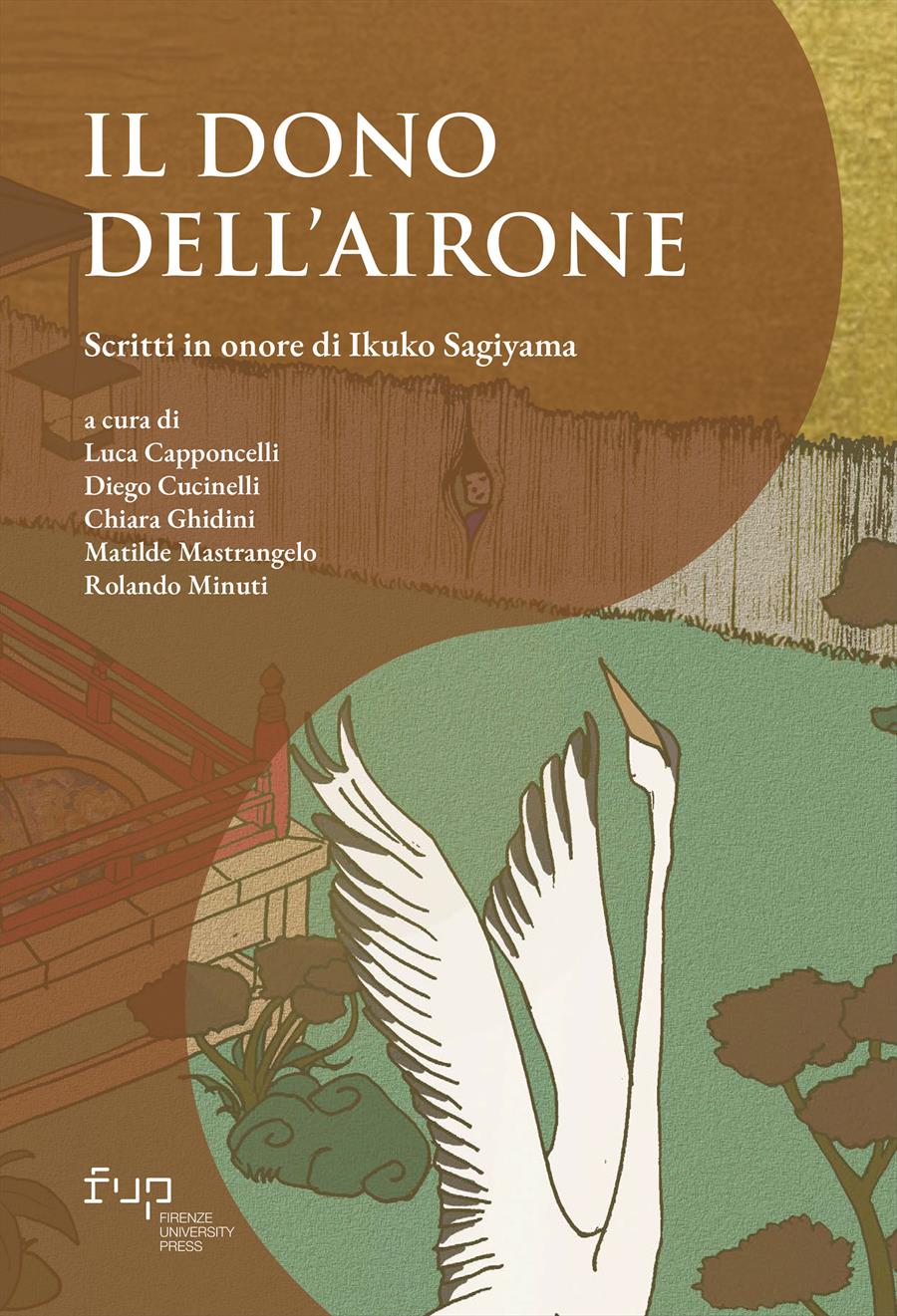- Il dono dell’airone
- Edited by Luca Capponcelli, Diego Cucinelli, Chiara Ghidini, Matilde Mastrangelo, Rolando Minuti
Volare nella notte su ali rilucenti. L’airone (sagi) nel Giappone premoderno tra letteratura, folklore e bestiari
- Diego Cucinelli
- © 2024 Author(s) |
- CC BY 4.0
- DOI: 10.36253/979-12-215-0422-4.06
The heron (sagi) holds a cherished place among avian figures in Japanese culture, although it has received less scholarly attention compared to other birds. Its significance can be traced back to some of the oldest surviving texts. References to white herons are present in the Man’yōshū (Collection of Ten Thousand Leaves, second half of the 8th century) and the Kokin waka rokujō (Six Quires of Ancient and Modern Japanese Poetry, late 10th century). Additionally, the docile bittern appears in the Heike monogatari (Tale of the Heike, 13th century), and the nō drama Sagi (The Heron) is another noteworthy example. Depictions of herons with long legs are found in the verses of Matsuo Bashō (1644-1694) and Yosa Buson (1716-1784). In the extensively studied cases mentioned above, the heron often emerges as an elegant motif set against aquatic landscapes, frequently associated with themes of solitude. However, in less explored areas of folklore and bestiaries, the heron takes on a supernatural dimension. It becomes linked to both water and fire, as well as concepts of life and death. To provide a comprehensive understanding of the representations of herons in premodern Japan, this essay will adopt a structured approach. It will commence by offering a summary of existing literature on the subject, establishing the groundwork. Subsequently, the essay will delve into the analysis of sources that have received relatively less attention, particularly focusing on folklore and bestiaries.
- Keywords:
- Heron,
- Bestiaries,
- Poetry,
- Folklore,
- Yōkai,
University of Florence, Italy - ORCID: 0000-0002-3773-2921
- Abe, Akio et al. a cura di. 1998. “Genji monogatari.” (6). Shinhen Nihon koten bungaku zenshū. vol. 17. Tokyo: Shōgakukan.
- Bun’ichi sōgō shuppan. a cura di. 1996. “Sei o jikkan suru sagiyama.” Birder 5 [numero speciale Sagi tte yappari omoshiroi].
- Cucinelli, Diego. 2021. Percorsi nella letteratura fantastica giapponese. Demoni e animali fantastici. Roma: Gangemi.
- Endō, Jirō, e Nakamura Teruko. 2004. “Manase Gensaku no chosaku no shomondai: ‘Sankyoshiyō bassui’ ‘Saiminki’ wa Gensaku no chosaku ka.” Nihon Ishigaku Zasshi 50: 547-68.
- Endō, Jirō, e Nakamura Teruko. 2007. “Manase Dōsan ‘Yakuseinōdoku” no kenkyū. Nihon Ishigaku Zasshi 53: 150-51.
- Fahr-Becker, Gabriele. a cura di. 2000. Arte dell’Estremo Oriente. Milano: Könemann.
- Foster, Michael D. 2009. Pandemonium and Parade. University of California Press.
- Fujiwara no Kintō. 2016. Wakanrōeishū. Raccolta di poesie giapponesi e cinesi da intonare (a cura di Andrea Maurizi e Ikuko Sagiyama). Torino: Ariele.
- Heibonsha Chihō Shiryō Sentā. a cura di. 1988. Tochigiken no chimei. Tokyo: Heibonsha.
- Heibonsha Chihō Shiryō Sentā. a cura di. 1991. Shigaken no chimei. Tokyo: Heibonsha.
- Heibonsha Chihō Shiryō Sentā. a cura di. 1993. Saitamaken no chimei. Tokyo: Heibonsha.
- Heibonsha Chihō Shiryō Sentā. a cura di. 1995. Shimaneken no chimei. Tokyo: Heibonsha.
- Imoto, Nōichi et al. a cura di. 1995. “Matsuo Bashōshū.” (1). Shinhen Nihon koten bungaku zenshū. vol. 70. Tokyo: Shōgakukan.
- Imoto, Nōichi et al. a cura di. 1997. “Matsuo Bashōshū.” (2). Shinhen Nihon koten bungaku zenshū. vol. 71. Tokyo: Shōgakukan.
- Imoto Nōichi et. al. a cura di. 2001. “Kinsei haiku haibun shū.” Shinhen Nihon kotenbungaku zenshū vol. 72, Tokyo: Shōgakukan.
- Inada, Hideo. 2011. “Yamaguchi Sagiryū no ichi (jō) – Eyama honsho shūkyokuo megutte.” Yamaguchi kenritsu daigaku gakujutsu jōhō 4: 13-28.
- Inoue, Sayaka. 2015. “Chishin no rikishi mai saikō.” Man’yō kodaigaku kenkyū nenpō 13: 1-14.
- Kajiwara, Masaaki, e Yamashita Hiroaki. a cura di. 1999. Heike monogatari 2. Tokyo: Iwanami Bunko.
- Komiya, Toyotaka. a cura di. 1930. Bashō renkushū. Tokyo: Iwanami Shoten.
- Migliore, Maria Chiara. a cura di. 2019. Man’yōshū. Raccolta delle diecimila foglie – Libro XVI: poesie che hanno una storia e poesie varie. Roma: Carocci.
- Miyamoto, Sachie, e Kumatani Azusa. 2007. Nihon no yōkai no nazo to fushigi. Tokyo: Gakushū Kenkyūsha.
- Murasaki Shikibu. 2012. La storia di Genji (a cura di Maria Teresa Orsi). Torino: Einaudi.
- Okada, Kikuo. 1986. “Naganoimiki Okimaro ron (ni).” Nihon bungaku kenkyū 22: 15-25.
- Satō, Katsuaki. 2008. “Haikai jiin Sagi no ashi gojūin bunseki, jō.” Wayō joshidaigaku kiyō, jinbunkei-hen 48: 1-14.
- Sei Shōnagon. 1965. Makura no sōshi (jō) (a cura di Matsuura Teishun e Ishida Jōji). Tokyo: Kadokawa Bunko.
- Takahashi, Kiwa. 2001. “Shiratori densetsu” no hitokōsatsu: shiratori ni natta Yamato Takeru.” Sendai shirayuri joshi daigaku kiyō 5: 171-184.
- Villani, Paolo. a cura di. 2006. Kojiki – Un racconto di antichi eventi. Venezia: Marsilio.
- Yamaoka Genrin. 1989. “Hyakumonogatari hyōban.” In Edo kaidan shū (ge), a cura di Takada Mamoru, 317-366. Tokyo: Iwanami Bunko.
- Yamashita, Keiko. 2021. Man’yō no tori. Tokyo: Seibundō shinkōsha.
- Zhuang-zi. 1982. Zhuang-zi (a cura di Liou Kia-hway, tr. it. di C. Laurenti e C. Leverd). Milano: Adelphi.
Chapter Information
Chapter Title
Volare nella notte su ali rilucenti. L’airone (sagi) nel Giappone premoderno tra letteratura, folklore e bestiari
Authors
Diego Cucinelli
Language
Italian
DOI
10.36253/979-12-215-0422-4.06
Peer Reviewed
Publication Year
2024
Copyright Information
© 2024 Author(s)
Content License
Metadata License
Bibliographic Information
Book Title
Il dono dell’airone
Book Subtitle
Scritti in onore di Ikuko Sagiyama
Editors
Luca Capponcelli, Diego Cucinelli, Chiara Ghidini, Matilde Mastrangelo, Rolando Minuti
Peer Reviewed
Number of Pages
390
Publication Year
2024
Copyright Information
© 2024 Author(s)
Content License
Metadata License
Publisher Name
Firenze University Press
DOI
10.36253/979-12-215-0422-4
ISBN Print
979-12-215-0421-7
eISBN (pdf)
979-12-215-0422-4
Series Title
Connessioni. Studies in Transcultural History
Series ISSN
2975-0393
Series E-ISSN
2975-0261
